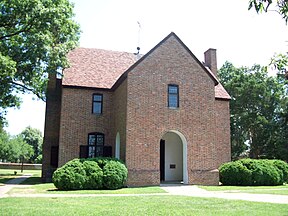St. Mary's City
| St. Mary's City Historic District | ||
|---|---|---|
| National Register of Historic Places | ||
| National Historic Landmark District | ||
|
State House of the Colony of Maryland , built 1676, reconstructed in 1934 |
||
|
|
||
| location | St. Mary's City, St. Mary's County , Maryland | |
| Coordinates | 38 ° 10 '50.3 " N , 76 ° 25' 46.7" W | |
| surface | 3.2 km² | |
| Built | 1634 | |
| NRHP number | 69000310 | |
| Data | ||
| The NRHP added | 4th August 1969 | |
| As NHLD declared | 4th August 1969 | |
St. Mary's City in St. Mary's County in the south of the American state of Maryland was the fourth settlement founded by European immigrants in North America in 1634. From then until 1694, the settlement at the mouth of the Potomac River , west bank of Chesapeake Bay , was the first capital of the English colony Province of Maryland .
In the 18th century, the city was completely abandoned by its residents and the houses fell into disrepair. The site became farmland, and in the 20th and 21st centuries, St. Mary's City is a sparsely populated unincorporated area .
Since the 1960s, the area of the former colonial capital has been the subject of extensive archaeological research on the settlement history of the 17th century; some typical buildings of the early colonial period have been reconstructed and are part of an open-air museum.
Because of its historical significance, St. Mary's City Historic District was designated a National Historic Landmark by the US Department of the Interior in 1969.
history
St. Mary's City was founded in 1634 as the fourth permanent English settlement on American soil (after Jamestown , Plymouth and the Massachusetts Bay Colony ). For the next 60 years the place was the county seat of St. Mary's County and the capital of the colony of Maryland.
When the capital of the colony was relocated to Anne Arundel's Towne , today's Annapolis , in 1694 , this was a loss of importance from which St. Mary's City could no longer recover. The settlement initially remained the administrative seat of the county, but in 1708 also lost the county seat to Seymour Town , 25 km northeast, today's Leonardtown . Most of the residents left the village over the following years, the houses fell apart or were demolished and the settlement area became farmland. 100 years later, around 1820, there were hardly any remains of the settlement to be seen.
Archaeological research and museum settlement
The last major building still standing in the early 19th century was the Maryland Colony's first State House , built in 1676 . When this too was demolished in 1829, nothing above the ground reminded of the former city. However, the memory of the settlement lived on, and in 1934 the State House was reconstructed to mark the 300th anniversary of Maryland. At this time, the first archaeological investigations took place on the site of the previous settlement, and the place has been officially recognized as an archaeological site since 1966. The area of the former capital has been an open-air museum since the 1970s, which illustrates the living conditions of the colonial era.
Since the intensification of research in the 1960s, several typical buildings of the original settlement have been reconstructed on the basis of archaeological finds and historical descriptions. The most striking of these buildings is the former Catholic Church, which was faithfully rebuilt between 2002 and 2009. The building was completed in 1667 as the first brick-built Catholic church building on American soil, but the governor had already decided in 1704 that the church should be closed again, after which the building was dismantled.
On August 4, 1969, the area was designated a National Historic Landmark District and at the same time included in the National Register of Historic Places (NRHP).
St. Mary's College of Maryland
The site is also home to St. Mary's College of Maryland , an educational institution founded in 1840 that is one of Maryland's most prestigious schools. In 2017 the college had around 1700 students.
See also
literature
- Patricia Heintzelman: St. Mary's City . NRHP nomination form. National Park Service, Historic Sites Survey, Washington 1975 ( Online ; PDF).
Web links
- Historic St. Mary's City Maryland , open air museum website.
- St. Mary's City Historic District , Maryland Historical Trust, Maryland's National Register Properties.
- smcm.edu , website of St. Mary's College.
Remarks
- ↑ St. Mary's County, Maryland, Historical Chronology , Maryland State Archives; Retrieved October 25, 2017.
- ↑ Notation with: A Brief History of Annapolis , visitannapolis.org; Retrieved October 25, 2017.
- ↑ Morris L. Radoff: The County Court Houses and Records of Maryland. Part One: The Courthouses. (PDF) . The Hall of Records Commission, State of Maryland, Annapolis 1960, pp. 129-133; Retrieved October 25, 2017.
- ^ John Hartsock: Vanished Colonial Town Yields Baroque Surprise . In: The New York Times, February 5, 1989; Retrieved October 25, 2017.
- ↑ An Archaeological Landscape (PDF) , Historic St. Mary's City; Retrieved October 25, 2017.
- ↑ St. Mary's City Historic District , Maryland's National Register Properties, Maryland Historical Trust; Retrieved October 25, 2017.
- ↑ Not just another pretty place ... , Historic St. Mary's City; Retrieved October 25, 2017.
- ^ Reconstructing the Brick Chapel of 1667 (PDF) , Historic St. Mary's City; Retrieved October 25, 2017.
- ↑ Listing of National Historic Landmarks by State: Maryland. National Park Service , accessed August 4, 2019.
- ↑ Digital Asset 69000310 , National Register of Historic Places; accessed October 24, 2017.
- ^ Key Facts , St. Mary's College; Retrieved October 25, 2017.



